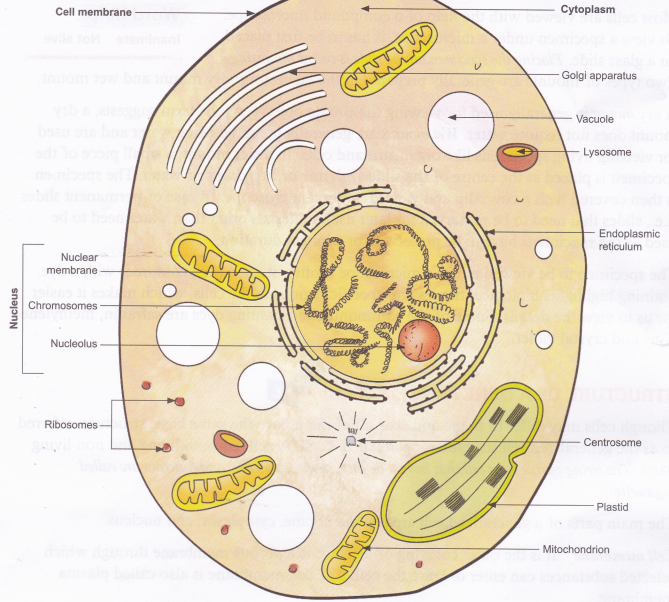Structure Of A Generalized Cell
Though cells may differ in shape and size, all of them have the same basic structure, referred to as the generalized cell structure or generalized cell. A cell has both living and non-living parts. The living parts of the cell that have a definite shape, structure, and function are called organelles.
The main parts of a generalized cell are cell membrane, cytoplasm, and nucleus.
Cell membrane: It is the outer covering of a cell. It is a porous membrane through which selected substances can enter or leave the cell. The cell membrane is also called plasma membrane.
Cytoplasm: It is a jelly-like fluid that fills up the part of the cell between the cell membrane and the nucleus. Several organelles are embedded in the cytoplasm.
Nucleus: It is considered to be the brain of the cell. Nucleus is surrounded by a membrane called the nuclear membrane and is filled with a semi-solid substance called the nucleoplasm. Thread-like structures called chromosomes are present in the nucleoplasm. Chromosomes carry genes, which transfer the characteristics of a cell to the new cells that are formed during cell division. Also present inside the nucleus is a round granule called nucleolus, which contains a network of fibrous material called chromatin fibres.
Figure shows a generalized cell. It is important to note that some of the organelles shown in figure may be present only in plant cells and not in animal cells and vice versa.

Let us learn about the cytoplasmic organelles shown in figure.
Golgi apparatus (or Golgi body): It is made up of tubules (long tube-like structures), vesicles (small vessels), and vacuoles and is responsible for the secretion of chemical substances like enzymes, hormones, and proteins.
Vacuole: It is a fluid-filled space enclosed in a membrane. Vacuoles store excess water, useful minerals, pigments, and many other substances.
Lysosome: Lysosomes contain chemical substances called enzymes that are capable of digesting cells and a variety of intra- and extra-cellular materials [intra, internal (inside); extra, external (outside)]. In times of emergency, lysosomes burst and destroy the cell. Hence, they are also called suicide bags of the cell.
Endoplasmic reticulum :It is a network of tubules and channels and is involved in the synthesis, storage, and transport of cell products.
Ribosomes: These are small granular structures scattered in the cytoplasm that act as sites of protein synthesis.
Centrosome: This structure is present only in animal cells. The main function of centrosomes is to initiate and regulate cell division.
Plastids: These are present only in plant cells. Plastids contain certain pigments that have a specific role to play in the functioning of the plant. Depending on the pigment colour, plastids are of three kinds: chloroplasts, chromoplasts, and leucoplasts.
- Chloroplasts contain the green pigment chlorophyll, which helps plants in making food.
- Chromoplasts contain non-green pigments that give colour to flowers and fruits.
- Leucoplasts are colourless and store food in the form of carbohydrates, fats, and proteins.
Mitochondria (singular mitochondrion): These are tiny spherical or rod-shaped bodies. They act as sites of energy production and are, therefore, called the powerhouses of the cell.